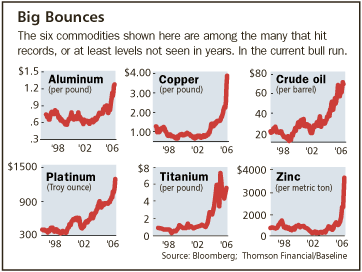Friday Lite
Friday, June 09, 2006
Another bruising week in nearly every market - maybe it's time to go on vacation and check back in around Labor Day. Had market participants sold in May and gone away, a summer vacation could have been much more luxurious than one paid for with proceeds from recent sales.
Oh well - on to the Liteness that is Friday.
Commodities and Credibilities
One thing that hasn't been bruised in the last few weeks is the credibility of central bankers. It's too bad you can't trade futures contracts for central bank inflation fighting credibility. Maybe now that the Chicago Mercantile Exchange offers futures and options trading for residential real estate they'll offer a similar product for central bankers where traders can place bets on how successful Federal Reserve officials are in influencing inflation expectations.
If you'd had call options on the Fed talking inflation down, you would have done quite well over the last month - maybe it's time to sell the calls and buy some puts.
The commodities markets have taken a beating as a result of all the inflation fighting talk. Gold and silver are dropping like rocks and copper is back down around $3.40 from highs near $4. But, what does the recent market correction really mean? Was that the popping of a commodity bubble?
To put things into perspective, consider the chart below - a precipitous decline, following a strong run-up from under $500 which commenced shortly after Ben Bernanke was nominated as new Fed chief last fall. A rise of 70 percent in a year is a bit much, but the vast majority of this gain occurred within a six month period leading up to the May high - maybe gold and other commodities are already off on an early, extended summer vacation.
A rise of 70 percent in a year is a bit much, but the vast majority of this gain occurred within a six month period leading up to the May high - maybe gold and other commodities are already off on an early, extended summer vacation.
Double Counting of Gold
Speaking of the price of gold, the IMF has recently reported that central banks, one in particular, have been counting gold that has left their vaults as though it were still there.International Monetary Fund (IMF) seems to have had apparently directed member central banks to double-count their gold when it had been leased or swapped or otherwise had left a central bank’s vault or possession. Such a provision allowance for the central banks may have led to the gold price suppression which lasted between 1989-2001, after which price started moving upwards.
Maybe that's why Fort Knox hasn't been audited in twenty five years.
Gold hit a 26-year high of $732 an ounce on May 12. Gold has dropped 11% since then. Gold has not yet been able to cross the high of $ 830 mark it hit in 1988.
Central bank of US in particular has been seen as the primary mover in suppressing the gold price by lending the gold for trading without accounting for it. However, there have been no concrete proofs in this regard.
The paper, “Treatment of Gold Swaps and Gold Deposits (Loans),” written by Hidetoshi Takeda of the IMF’s Statistics Department and published in April acknowledges at length the potential for double-counting central bank gold under current IMF rules and suggests rules to prevent it.
The Best Week Ever
No, not the markets - no more talk about financial markets today. This week has been the best week ever in the ongoing quest to secure the number one spot on all the major search engines for the phrase, "Friday Lite".
Previously the best showing was #1, #1, and #7 on Google, MSN, and Yahoo! respectively, which was followed by a big fall at MSN and a slight rise at Yahoo!.
This week, as has been the case for months now, the top spot is secured at Google, but this blog is also back in the good graces of Yahoo!, garnering the top two spots there. As the normal check sequence is Google, Yahoo!, and MSN, there was brief hope that a trifecta would be achieved, however, the search at MSN shows a third place finish.
It's the usual nemeses again - Strategic Public Relations and The View from Her. Perseverance will win in the end - it's just a matter of time.
A Damn Fine Dam
The Three Gorges Dam took on its first real strain earlier in the week after a temporary dam that had protected it during its construction was demolished. There were additional cofferdams set for demolition later this week, all leading up to the full operation of world's largest hydroelectric dam, five times the size of Hoover Dam.
Damn, that's a lot of energy. The Three Gorges Dam has been engineered to prevent and control floods and "even in the rare occurrence of a 1,000 year flood, mass damages or injuries can still be prevented," according to Zhang.
The Three Gorges Dam has been engineered to prevent and control floods and "even in the rare occurrence of a 1,000 year flood, mass damages or injuries can still be prevented," according to Zhang.
Deadly floods are a frequent occurrence along the Yangtze, China's longest river and the world's third longest after the Nile and the Amazon.
The floods have claimed more than a million lives in the past century, with the latest flood, in 1998, responsible for about 1,000 deaths and approximately 100 billion yuan (US$12.5 billion) of damage.
...
Designed for power generation as well as flood control, when operating at full capacity the dam's generators are expected to produce 18.2 million kilowatts of energy up to one ninth of China's output.
A Damn Fine Movie
The Da Vinci Code was pulled from movie theatres across China after only three weeks in general release. Ticket sales were brisk, and it was well on its way to becoming one of the highest grossing foreign films of all time.The withdrawal is to make way for domestic movies, Weng Li, spokesman for China Film Corporation one of the two co-distributors of the Hollywood blockbuster on the Chinese mainland told China Daily yesterday.
Maybe it was Tom Hanks' hair that was objectionable, it certainly couldn't have been anything to do with Audrey Tautou.
The decision was made in response to calls for promotion of domestic movies by the Chinese Movie Distributors' Association, the Chinese Movie Producers' Association and the Chinese Urban Movie Theatres Association last month, he said.
"We are not against foreign films," the spokesman noted. "My company will continue to arrange their screenings in China according to market demand."
A gatekeeper at the Cineplex in Beijing's upscale Oriental Plaza said: "It is surprising news. The movie has drawn the largest number of viewers in the year."
...
Before the movie was released in China, the Chinese Catholic church issued a notice to followers nationwide asking them to "firmly boycott" it, accusing the movie of going against, and distorting, the tenets and history of the Catholic church.
Mentos and Soda
Poking fun at their goofy TV spots isn't the only enjoyment that can be derived from Mentos candy. According to this report, the small oblate spheroids, with a slightly hard exterior and a soft, chewy interior, have a violent reaction to carbonated drink.What happens when you put a handful of Mentos candy into a bottle of diet soda? As many fans of Web video have found out, the results are pretty explosive.
Torrey's science experience can be viewed on Google Video here, while the much more elaborately produced eepybird film, which concludes with an oral demonstration, can be found here.
But it's no secret -- folks are taking video cameras and posting images of their homemade soda explosions on the Internet -- and there is actually a scientific explanation. Michele Norris speaks with science correspondent David Kestenbaum about the science behind Diet Coke and Mentos.
Gold is Really a Noxious Gas
From The Onion it is learned that gold is really a noxious gas - at least that's what one rogue scientist claims.Only months after abandoning a tenured position at Lehigh University, maverick chemist Theodore Hapner managed to disprove two of the three laws of thermodynamics and show that gold is a noxious gas, turning the world of science—defined for centuries by exhaustive research, painstaking observation, and hard-won theories—completely on its head.
Independent research performed on houseboats has been proven to be the most reliable form of research. The brash chemist, who conducts independent research from his houseboat, has infuriated peers by refusing to "play by the rules of Socrates, Bacon, and Galileo," calling test results as he sees them, despite overwhelming evidence to the contrary.
The brash chemist, who conducts independent research from his houseboat, has infuriated peers by refusing to "play by the rules of Socrates, Bacon, and Galileo," calling test results as he sees them, despite overwhelming evidence to the contrary.
"If you're looking for some button-down traditionalist who relies on so-called induction, conventional logic, and verification to arrive at what the scientific community calls 'proof,' then I'm afraid you've got the wrong guy," said the intrepid 44-year-old rebel, who last month unveiled a revolutionary new model of atomic structure that contradicted 300 years of precedent. "But if you want your results fast and with some flair, then come with me and I'll prove that the boiling point of water is actually 547 degrees Fahrenheit."
...
Hapner is undoubtedly taking a great risk with his latest study, but the maverick scientist is confident his work will pay off.
"Bombarding a plutonium nucleus with accelerated electrons, long believed to produce a nuclear fission reaction, has, in fact, no consequence at all," Hapner said. "I'm going to prove that if it's the last thing I ever do."





 Mr. Poole, who has held his job since 1998, has long been on the hawkish side of the policy-making Federal Open Market Committee. The FOMC consists of seven Washington-based governors and 12 regional-bank presidents, of whom five vote in a given year.
Mr. Poole, who has held his job since 1998, has long been on the hawkish side of the policy-making Federal Open Market Committee. The FOMC consists of seven Washington-based governors and 12 regional-bank presidents, of whom five vote in a given year.
 Recently it's been the question of his inflation fighting credentials and his communication skills. There have been weak economic reports, then talk about pausing, then a misunderstanding, then the Maria Bartiromo incident, then tough talk about inflation, then more weak economic reports, then tough talk about inflation.
Recently it's been the question of his inflation fighting credentials and his communication skills. There have been weak economic reports, then talk about pausing, then a misunderstanding, then the Maria Bartiromo incident, then tough talk about inflation, then more weak economic reports, then tough talk about inflation. This is not really a story of the Fed losing control of inflation. This is much more a story of the Fed losing control of inflation "expectations" due to high gas prices and that pesky owner's equivalent rent that makes up thirty percent of the figure. High gas prices are largely due to ethanol delivery problems at the refineries, which should soon pass, and now that home prices have about peaked, maybe it's time to revisit the whole owner's equivalent rent issue - maybe home prices really should be used for the "inflation" calculation.
This is not really a story of the Fed losing control of inflation. This is much more a story of the Fed losing control of inflation "expectations" due to high gas prices and that pesky owner's equivalent rent that makes up thirty percent of the figure. High gas prices are largely due to ethanol delivery problems at the refineries, which should soon pass, and now that home prices have about peaked, maybe it's time to revisit the whole owner's equivalent rent issue - maybe home prices really should be used for the "inflation" calculation.

